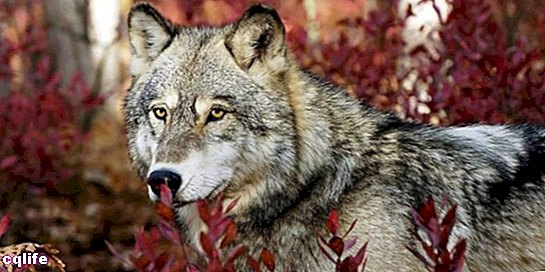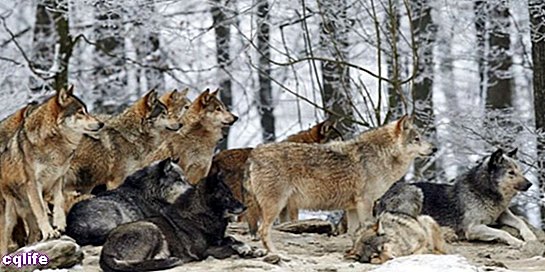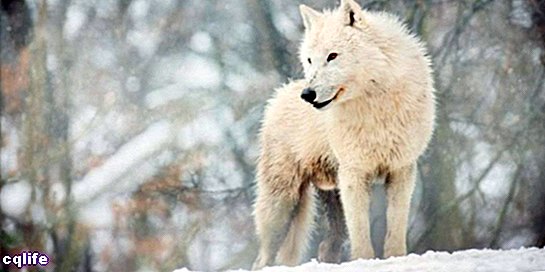- What are wolves?
- Characteristics of wolves
- Wolf behavior
- Wolves feeding
- Habitat of wolves
- Wolf types
- Howling wolf
We explain everything about wolves, their behavior, feeding and other characteristics. Also, what do they use their howls for?

What are wolves?
The wolf, with a scientific name Canis lupus, is a type of mammal carnivorous quadruped, genetically related to the domestic dog (in fact, they are considered basically the same species). He lives in herds and before his encounter with him human being, it was one of the most abundant predators in North America, Eurasia and the Middle East.
Wolves have intrigued humans since ancient times, and many cultures chose to identify with them, as they are characterized by their ferocity, their pack spirit and their tenacious survival in hostile environments, such as tundras northern frost America Y Europe.
The word wolf comes from the Latin word lupus, which has the same meaning, and which was used in feminine to refer to prostitutes (perhaps because of working under the moon). Words like "lupanar" (brothel) also come from there.
Thus was also born the idea of the werewolf (werewolf, in English), which would be the cross between the two species, whose transformations obey the Moon full. The wolf is also usually the protagonist of myths very diverse, like that of Romulus and Remus, founders of Rome, who were orphans and were suckled by a she-wolf.
He is also a usual antagonist of children's stories, always depicting him hungry and angry, possibly because in ancient times he came to constitute a real danger to travelers, lost children or the herd.
Today, however, although they continue to abound in diverse wild habitats, much smaller than they once were, they are considered a Threatened species by the way of life of the human being.
Characteristics of wolves

Wolves have the following general characteristics:
- They are quadruped animals, mammals, with bodies between 60 and 90 cm high and a weight between 32 and 70 kg. They are usually between 1.30 and 2 meters long. They have a long tail, and are not, in principle, too different anatomically from a dog.
- Their bodies are configured to withstand long-distance travel, with a narrow chest and powerful back and legs. Therefore, they can reach 10 km / h in trot and 65 km / h in full pursuit. They have been seen covering about five meters in sprinting.
- On the legs they have non-retractable claws, which allow them to hold on to various slippery surfaces. Its body is covered with thick fur, of different colors, going from brown to white.
- The teeth of wolves are formidable, identical to that of the dog, but larger. They have a keen sense of smell as well as night vision, which make them fearsome hunters.
- They are distinguished from coyotes and jackals in their long, thick snouts, and from foxes in size and ear shape.
Wolf behavior

The male and female leading the pack are called alphas.
Rarely does a wolf walk on its own. In fact, they are usually organized in packs of two to twenty individuals, with a strict social hierarchy, whose behaviour is in evidence during the hunt.
At the head of the herd there is a breeding male and female, whose bond is almost always monogamous, and who are called as alphas. They are those who impose order within the herd and who control resources, such as the order of the herd. feeding.
Sometimes a wolf leaves his pack and forms a new one, for which they must find a mate and a territory to claim, since the wolves control their habitat. That is why it is rare for a wolf to pierce the territory others, unless it is a pack willing to claim it as their own. Other types of intruders, such as dogs and even humans, will receive the same degree of hostility from wolves.
Wolves feeding

Wolves are hunters, and their diet is eminently carnivorous. A wolf can only eat 3-4 kilos of meat per meal, which is a whopping one ton of meat per year. This can vary in adverse weather conditions, in which they will eat more to have energy reserves.
Their diet consists mainly of sheep, goats, pigs, deer, reindeer, horses, elk, yaks, antelope, bison, birds, and rodents and other small animals. Depending on the habitat, they may even feed on stranded salmon, seals, or whales. Cannibalism is not uncommon in times of scarcity, although these animals can survive for a long time without eating.
Habitat of wolves

These animals have been the most widely distributed throughout the planet, especially in the northern regions of America and Eurasia. But much of its habitat was lost to the expansion of the communities human.
From North America, Japan, Western Europe, Russia and India, significant numbers of wolves are currently conserved only in Russia. There are also small populations in Greenland, Canada and some Arctic islands, China, Kazakhstan, Nepal, Mongolia, as well as in Africa and the Middle East.
Wolf types

There are several subspecies of wolves, that is, types that have adapted to their environmental environments over time, including the common dog. This classification responds to its place of origin, and includes 37 subspecies, the main ones being the following:
- Canis lupus familiaris. The domestic dog in its wide variety of breeds.
- Canis lupus lupus. The wolf itself, the one in the stories of the Brothers Grimm, typical of Europe and part of Asia.
- Canis lupus albus. White fur, typical of northern Russia and the steppes Siberian.
- Canis lupus arctos. Also known as the polar wolf, thick-haired, common in Canada and other circumpolar regions.
- Canis lupus baileyi. The Mexican wolf, the smallest of all subspecies, is typical of Mexico and the southern United States.
- Canis lupus manningi. Known as the Baffin wolf, because it only inhabits the island of that name in Canada and other islands east of Greenland. It is the smallest of the Arctic wolves.
- Canis lupus pambasileus. Also called the Yukon wolf or the Alaskan black wolf, since it is obviously endemic to those regions Northern North America. It is one of the largest subspecies in the world.
- Canis lupus dingo. Called simply "dingo", it is a short-haired subspecies, typical of Australasia, that is, of Australia and Southeast Asia.
- Canis lupus arabs. The small gray-colored Arabian wolf lives in the Middle East: Jordan, Egypt, Israel and the Arabian peninsula.
- Canis lupus italicus. Endemic to the Italian peninsula, it is the most recent of the subspecies, since it was previously thought to be a totally different species.
- Canis lupus crassodon. Called the Vancouver wolf, since it inhabits this North American island in the Pacific Northwest. Endangered, it is one of the most sociable of all wolf subspecies, living in packs of up to 35 specimens.
- Canis lupus occidentalis. Known as Mackenzie's wolf, it is a large variant with gray-black fur, endemic to Alaska and northwestern Canada, around the Mackenzie River.
- Canis lupus pallipes. The Indian short-haired wolf inhabits the southern regions of Pakistan, and other countries such as Iran, Turkey, Saudi Arabia and Israel.
- Canis lupus signatus. Better known as the Iberian wolf, it is endemic to the Iberian Peninsula (Spain and Portugal).
- Canis lupus hallstromi. The rarest subspecies listed here is known as the "New Guinea Singing Dog" and is a very close relative of the Australian dingo, which would have been isolated in this region long enough to change its appearance.
Howling wolf

One of the most characteristic features of the wolf, for which it has become famous, is its prolonged and nocturnal howl, which serves as a mechanism for locating the herds and demarcation of the borders between their territories.
The wolf howls to communicate with its peers and rivals, thus avoiding unwanted encounters between packs. This is why lone wolves rarely respond to howls they hear: they lack territory to demarcate.
